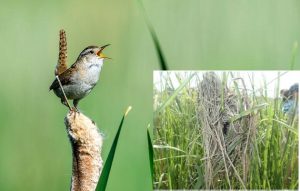
Facebook Twitter Instagram YouTube RSS Feed
Written on: December 12th, 2017 in Wetland Animals
by Erin Dorset, DNREC Wetland Monitoring & Assessment Program
Tidal salt and brackish marshes are amazing wetland places that are home to many unique plant and animals—including some really cool wetland birds. Many birds depend on salt and brackish marshes for food, shelter, and nesting areas. Some of these birds are large and easily seen, while others are small and secretive—you many not even know they are there.
Read on to meet some of the amazing birds that use salt and brackish marshes, and next time you’re by the coast, look and listen to see if you can spot some!
These guys are some of the easiest birds to spot in a tidal marsh. They are tall and are bluish-gray overall, and you’ll often see them wading around in the water with their long legs. Their long, spear-like bill helps them catch fish. If you are lucky enough, you may even see one of their rookeries, or breeding areas, during nesting season.
These sparrows are some of the most secretive birds of the salt marshes. They are fairly small and fly low across the grasses, only to quickly disappear within them. When the males sing, their song is so quiet that it sounds almost like a whisper. They like to make their nests on the ground, often under tufts of salt meadow hay (Spartina patens), to hide them from predators. Keep your eyes peeled and your ears open and you might just be lucky enough to spot one of these secretive birds.

Marsh wren, National Audubon Society, Marsh wren nest, DNREC’s Wetland Monitoring & Assessment Program
You will probably hear these little birds before you see them; although they are small, they have a loud and bubbly song, and they certainly aren’t afraid to sing it! Their little brown bodies blend in with the tall grasses of brackish marshes that they like to perch on, often with each leg on two different grass blades. Their nests are off of the ground and are weaved out of grass pieces, creating a sort of elevated basket with a side entrance.
Clapper rails are much larger than salt marsh sparrows, but they are still pretty secretive. Their call is a loud “kek kek”, and you’ll often hear it when planes startle them. They are often hidden in salt marsh grasses, but they do come out to muddy or shallow water areas to feed on crustaceans and small fish. They make their nests out of marsh grasses on the ground, and the nests can be tricky to find.
Willets are light grayish-brown birds with bright white marks on their outspread wings. They feed on insects and crustaceans in marshes, mudflats, and along beaches. They make their nests in salt marshes out of grasses, and the nests blend in very well with their surroundings. Their call is often very loud, particularly when they feel their nest is threatened.
Great egrets are pretty easy to spot in marshes due to their relatively large size and their bright white color. They use their large bill to catch fish as they wade around in mud and shallow waters. Like great blue herons, they nest in colonies. You may also see snowy egrets in the marshes, which are similar in appearance. The tricks to tell them apart are that great egrets have yellow bills and black legs and feet, while snowy egrets are smaller in size, have blackish bills, and have black legs with yellow feet.
Osprey are birds of prey that are smaller than the bald eagle, and catch fish right out of the water with their sharp talons. They like to fly over marshes looking for fish in nearby waters, and will often hover in one spot when they think prey is near. Osprey like to nest on tops of dead trees, but they will also readily nest on man-made nesting platforms in salt marshes. Their nests are made of many sticks and are very large and visible, so keep a look out and you might find one.
As you have learned, birds that you see here, and many others, rely on salt and brackish marshes for survival. Unfortunately, many of them are facing trouble as climate change, rising sea levels, and human disturbance negatively affect their nesting and feeding wetland habitat. It’s up to people like you to spread the word to help them and their habitats!
The great news is, there are amazing online resources out there to learn more detailed information about these and other coastal marsh birds and the dangers they are facing from habitat changes. You can even become a citizen scientist and record your bird observations for scientists to use to help these birds out. Here are a few wonderful resources to learn more, have fun, and participate in marsh bird conservation: